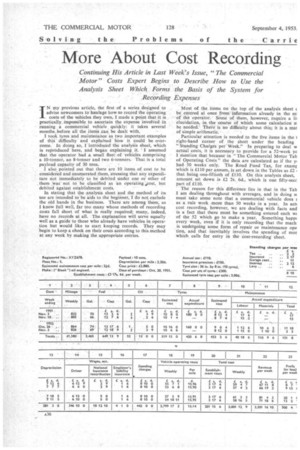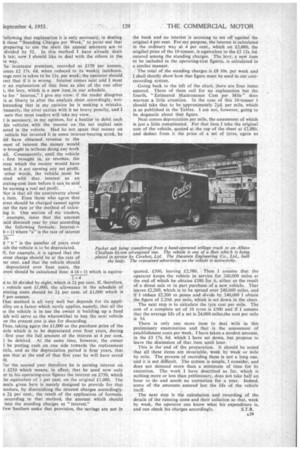More About Cost Recording
Page 54

Page 57

If you've noticed an error in this article please click here to report it so we can fix it.
Continuing His Article in Last Week's Issue, "The Commercial Motor" Costs Expert Begins to Describe How to Use the Analysis Sheet Which Forms the Basis of the System for Recording Expenses
/ , N my previous article, the first of a series designed to advise newcomers to haulage how to record the Operating costs of the vehicles they own, I made a point that it is practically, impossible to ascertain the expense involved in running a commercial vehicle quickly: it takes several months,,before all the items ,can be dealt with.
I took tyres and maintenance as two important examples of this difficulty and explained how it could be overcome. In doing so, I introduced the analysis sheet, which is reproduced here, and began explaining it. ' I assumed that the. operator had a small ffeet of vehicles comprising a 10-tonner, an 8-tonner and two 6-tonners. That is a total payload capacity of 30 tons.
I also pointed out that there are 10 items of cost to be considered and enumerated them, stressing that any expenditure not immediately to be debited under one or other of them was not to be classified as an operating ,cost, but debited against establishment costs.
In stating that the analysis sheet and the method of its use are intended to be aids to the beginner, I do not exclude the old hands in the business. There are among them, as I know full well, far too many whose methods of recording costs fall short of what is really required; many, indeed, have no records at all. The explanation will serve equally well as a guide to those who already have vehicles in operation but would like to start keeping records. They may begin to keep a check on their costs according to this method at any week by making the appropriate entries. Most of the items on the top of the analysis sheet ( be entered at once from information already in the mi of the operator. Some of them, however, require a iii elucidation, in the course of which some calculation' IT• be needed. There is no`difficulty about this; it is a mat of simple arithmetic.
Particular attention is needed to the five items in the right-hand corner of the sheet under the heading "Standing Charges per Week." In preparing to deal w actual costs, it is necessary to provide for a 52-week ye I mention that because in "The Commercial Motor Tab of Operating Costs" the data are calculated as if the yi had 50 weeks only. The Road Fund Tax, for examr which is 1110 per annum, is set down in the Tables as £2 • that being one-fiftieth of £110. On this analysis sheet, amount set down is £2 2s, 6d., which is one fifty-sece part of 010.
• The reason for this difference lies in that in the Tab I am dealing throughout with averages, and in doing st must take some note that a commercial vehicle does as a rule work more than 50 weeks in a year. In act] cost recording, however, we are dealing with facts and is a fact that there must be something entered each wt of the 52 which go to make a year. Something happr every week, even if it is only recording that the mach is undergoing some form of repair or maintenance ope tion, and that inevitably involves the spending of mor which calls for entry in the cost-recording sheet. ;Crflowing that explanation it is only necessary, in dealing It these "Standing Charges per Week," to point out that preparing to use the sheet the annual amounts are to divided by 52. In this method I have already dealt h tax; now I should like to deal with the others in the le way.
The insurance premium, recorded as £150 per annum, omes £2 17s. 6d. when reduced to its weekly incidence. rage rentis taken to be lls, per week; the operator should reet that if it is wrong. Interest-comes next and I must an explanation of that item as also of the one after t; the levy, which is a new itern.in. our schedule.
foi Interest," I give my view: if the reader disagrees is at liberty to alter the analysis sheet accordingly, nothstanding that in my opinion he is making a mistake. rtunately, the error carries with it no heavy penalty, and I sure that most readers will take my view. t is necessary, in my opinion, for a haulier to debit each his vehicles with the interest on the net capital sum ested in the vehicle. Had he not spent that money on vehicle but invested it in some interest-bearing stock, he ild have obtained revenue to the aunt of interest the money would re brought in without doing any work all. Consequently, until the vehicle ; first brought in, as revenue, the arest which the money would have tied, it is not earning any net profit. other words, the 'vehicle. must be )ited with that interest as an ,Ttating-cost item before it can be said
be earning a real net profit. ' N-or is that all the controversy about s item. Even those who agree that crest should he charged cannot agree out the rate or the method, of calcuing it. One .section of my readers, .example, insist that the amount )uld diminish year by year according the following formula: Interest= b + 1) where "a" is the rate of interest
2b
d " b" is the number of years over ich the vehicle is to be depreciated. If, for example, it is agreed that the crest charge should be at the rate of )er cent. and that the vehicle should depreciated over four years, the crest should be calculated thus: 4 (4+1) which is equiva
2 x 4 it to 20 divided by eight, which is 24 per cent, if, therefore, t vehicle cost £1,000, the allowance in the schedule of crating costs should be 24 per cent. of £1,000 which is 5 per annum.
[hat method is all very well but depends for its appli)ility on a factor which rarely applies, namely, that all the le the vehicle is in use the owner is building up a fund ich will serve as the wherewithal to buy the next vehicle en the present one is due for discarding.
thus, taking again the £1,000 as the purchase price of the sick which is to he depreciated over four years, during . first year the full amount of the interest at 4 per cent. 1 be debited. At the same time, however, the owner I be putting cash on one side towards the replacement :dole, and as the depreciation period is four years, that. arts that at the end of that first year he will have saved i0.
or the second year therefore he is earning interest on .t £250 which means, in effect, that he need now only er in his operating-cost figures the interest on £750, which :he equivalent of 3 per cent on the original £1,000. The rnula given here is merely designed to provide for that )cedure, by diminishing the interest charges accordingly.
e 2i per cent., the result .of the application of formula, according to that method, the amount which should into the standing charges as "interest."
Few hauliers make that provision, the savings are not in the bank and no interest is accruing to set off against the original 4 per cent. For my purpose, the interest is calculated in the ordinary way at 4 per cent., which on £2,880, the original price of the 10-tonner, is equivalent to the £2 12s. 6d, entered among the standing charges. The levy, a new item to be included in the operating-cost figures, is calculated in a similar manner.
The total of the standing charges is £8 10s. per week and I shall shortly show how that figure must be used in our costrecording system.
Going back to the left of the chart, there are four items entered. Three of them call for no explanation but the fourth, "Estimated Maintenance Cost per Mile" does warrant a little attention. [r; the case of this 10-tonner I should take that to be approximately 20. per mile, whichis as published in the Tables. I am not, however, going to be dogmatic about that figure.
Next comes depreciation per mile, the assessment of which is just a little complicated. For that item I take the original cost of the vehicle, quoted at the top of the sheet at £2,880, and deduct from it the price of a set of tyres, again as
quoted, £300, leaving £2,580. Then I assume that the operator keeps• the vehicle in service for ,240,000 miles at the end of which he obtains £380 for it, either as the result of a direct sale or in part purchase of a new vehicle. That leaves £2,200, which is to be spread over 240,000 miles, and if I reduce £2,200 to pence anddivide by 240,000 I obtain the figure of 2.20d. per mile, which is set down in the chart.
The next step is to calculate the tyre cost per mile. The cost of a complete set of 10 tyres is 4300 and if I assume that the average life of a set is 24,000 miles,the cost per mile is 3d.
There is only one more item to deal with in this preliminary examination and that is the assessment of establishment costs per week. I have taken a modest amount, in the £3 '17s. 6d. which I have set down, but propose to leave the discussion of that item until later.
This is the end of the preparation. It should be noted that all these items are invariable, week by week or mile by mile. The process of recording them is not a long one, and it is not difficult. The system is simple, I consider, and does not demand more than a minimum of time for its execution. The work I have described so far, which is nothing more or -less than preliminary, does not take half an hour to do and needs no correction for a year. Indeed, some of the amounts entered last the life of the vehicle itsalf.
The next step is the calculation and recording of the details of the running costs and their collation so that, week by week, the operator can know what his expenditure is, and can check his charges: accordingly. S.T.R.




















































































